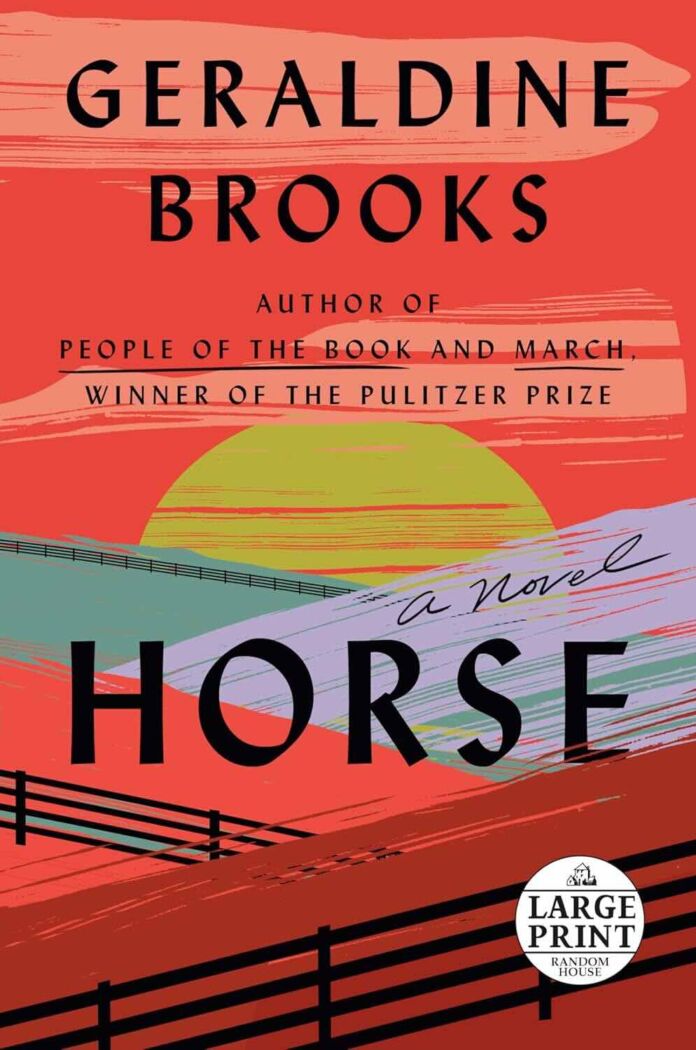Horse by Geraldine Brooks is a sweeping, multilayered novel that masterfully weaves together art, history, science, and an unflinching exploration of America’s enduring legacy of racism. Drawing inspiration from the remarkable true story of the legendary racehorse Lexington, Brooks crafts a poignant narrative that spans three centuries and intertwines the lives of an enslaved groom, a 19th-century artist, a mid-20th-century art dealer, and contemporary scientists and historians.
With a deft hand, Brooks captures the essence of each era, presenting a vivid portrayal of the antebellum South, the mid-20th century art scene, and modern-day America. The novel’s ambitious structure, alternating between time periods and perspectives, is both its greatest strength and, at times, a stumbling block, as certain storylines feel more compelling and complete than others.
Plot Overview: A Journey Through Time
The novel opens in 1850 Kentucky, where an enslaved boy named Jarret forges an unbreakable bond with a bay foal who would become the legendary racehorse Lexington. Geraldine Brooks immerses readers in the world of horse racing, revealing not only the triumphs and trials of the racetrack but also the deep-seated injustice and exploitation at the heart of the sport. As the Civil War looms, Jarret and Lexington’s story becomes one of survival, sacrifice, and the struggle for freedom.
Fast forward to 1954, and the narrative shifts to Martha Jackson, a forward-thinking New York City art dealer. When Martha stumbles upon a mysterious 19th-century equestrian painting, her obsession with uncovering its history brings new life to the legacy of Lexington and the unsung Black horsemen who played a critical role in his success.
In 2019, the story comes full circle as Jess, an Australian scientist at the Smithsonian, and Theo, a Nigerian-American art historian, find themselves connected through their shared fascination with the horse’s bones and the untold stories of Black grooms. Their journey of discovery sheds light on the hidden histories buried beneath America’s polished surface, confronting the realities of systemic racism in both the past and the present.
Character Analysis: Complex and Richly Drawn
Brooks excels at creating characters that feel authentic and multidimensional. Jarret is the novel’s beating heart, a young man whose gentleness and understanding of horses contrast starkly with the brutal world he inhabits. His relationship with Lexington is tender and profound, underscoring the novel’s exploration of animal and human empathy.
Martha Jackson brings an element of artistic intrigue, offering readers a glimpse into the art world of the 1950s. Her tenacity and willingness to take risks mirror the broader themes of courage and the search for truth. Meanwhile, Jess and Theo provide a modern lens through which Brooks examines race, identity, and academia’s often fraught relationship with history.
However, not all characters receive equal treatment. While Jarret’s and Theo’s narratives shine, Martha’s storyline occasionally feels less developed, lacking the same depth of emotional resonance. Some readers may find themselves yearning for a more balanced exploration of each character’s journey.
Writing Style: Lyrical Yet Unflinching
Brooks’s prose is both lyrical and precise, capturing the beauty of the natural world and the harsh realities of human history with equal skill. Her ability to shift tones between eras is impressive, and her meticulous research is evident in every chapter. The dialogue is sharp and believable, contributing to the rich tapestry of voices that populate the novel.
At times, however, the narrative’s ambition to cover so much ground can lead to uneven pacing. The historical segments often captivate more than the contemporary storyline, which occasionally slows the momentum of the novel.
Themes: Art, Race, and Redemption
Central to Horse by Geraldine Brooks are themes of art and legacy. The novel highlights how art can preserve history, offering a means to reclaim lost stories and honor forgotten lives. Brooks delves deep into America’s history of racism, illustrating how past injustices continue to shape the present. She skillfully juxtaposes the triumph of Lexington’s racing career with the exploitation of the Black men who made his success possible.
Redemption and the quest for truth also permeate the narrative. The characters’ journeys often revolve around uncovering hidden histories, seeking justice, and finding ways to honor those who came before them.
My Personal Take: A Hauntingly Beautiful Read
Horse by Geraldine Brooks is a novel that lingers long after the final page is turned. Brooks’s ability to connect disparate historical threads into a cohesive and emotionally resonant story is truly remarkable. While some plotlines may not feel as fully realized as others, the novel’s powerful message and the strength of its primary characters make it a worthy read.
The novel’s portrayal of systemic racism—both historical and contemporary—is nuanced and thought-provoking. It challenges readers to confront uncomfortable truths and consider how the echoes of history reverberate through the present.
Wrapping It Up: A Recommended Read
Horse by Geraldine Brooks is a masterful exploration of art, history, and human spirit. It offers a poignant reminder of the stories that have been overlooked and the people who deserve to be remembered. Fans of historical and literary fiction will find much to admire in Brooks’s latest work.
Recommended for readers who enjoyed:
- The Night Watchman by Louise Erdrich
- The Nickel Boys by Colson Whitehead
- People of the Book by Geraldine Brooks
- Homegoing by Yaa Gyasi
With its blend of meticulous research, rich storytelling, and insightful social commentary, Horse is a testament to Geraldine Brooks’s skill as a writer and historian. This novel is not just a story of a horse but a story of America—its past, its present, and the complex, often painful legacies that connect the two.





